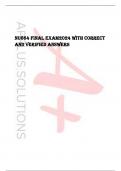NU664 Final exam2024 with correct
and verified answers
,Foreign bodies - CORRECT ANSWERS--Soft, irregularly shaped objects are graspable
with a bayonet forceps, alligator forceps, or curved hook
-Round or breakable objects can be removed using a wire loop, a curette, or right-angle
hook slowly advanced beyond the object and withdrawn carefully
-Disk, coin-shaped, or button batteries must be removed emergently
-Spherical objects are the most difficult to remove and require referral to an
otolaryngologist
-If the object is made of iron, nickel, or cobalt, a magnet may be used for retrieval
-Insects should be suffocated with mineral oil, then ear can be irrigated, or the child can
be referred to ENT for removal
-If the foreign body cannot be extracted on the first few attempts or cannot be removed
without risking damage to the external canal or TM, or if there is worsening pain, then
refer the child to an ENT
Epiglottitis - CORRECT ANSWERS--A life-threatening illness characterized by
inflammation of the epiglottis the aryepiglottic folds, and the ventricular bands at the
base of the epiglottis
-If this is suspected - do not examine the throat
-Signs - inspiratory and sometimes expiratory stridor, drooling, aphonia, and high fever,
rapidly progressive respiratory obstruction and prostration, flaring of the ala nasi and
retraction of the supraclavicular, intercostal, and subcostal spaces, child assumes a
hyperextension of the neck
-In older children - sore throat, dysphagia, stridor, irritability, restlessness, and brassy
cough; airway obstruction follows within 2-24 hour; the child sits with arms back, trunk
forward, neck hyperextended, and chin thrust forward (tripod position)
-Interventions - airway management ASAP; early consultation with a pediatric
otolaryngologist and anesthesiologist is key; establish airway and start antimicrobials;
do not place in supine position, immediately transport to the ER
-Diagnosed in the OR by depressing the tongue to view the swollen cherry-red epiglottis
-Nasotracheal intubation, IV broad-spectrum antibiotics, which can include
ampicillin/sulbactam, cefotaxime, ceftriaxone, or clindamycin of penicillin allergy with the
addition of vancomycin if MRSA is suspected; oxygen and respiratory support
Community acquired pneumonia - CORRECT ANSWERS--Drug of choice -
Azithromycin 10 mg/kg/day once on day 1 and then 5 mg/kg/day for the next 4 days
Appendicitis - CORRECT ANSWERS--Inflammation of the appendix the leads to
distention and ischemia that can result in necrosis, perforation, and peritonitis or
abscess formation
, -Poorly defined periumbilical pain; acute onset of severe pain is not typical of acute
appendicitis; a shifting of pain to the RLQ may occur after a few hours and become
more intense, continuous, and localized; nausea and vomiting, anorexia, stool with
mucus, fever may or may not occur
-Physical exam - involuntary guarding, RLQ rebound tenderness, pain over McBurney
point, positive psoas sign or obturator sign, rovsing sign or rebound tenderness
Colic - CORRECT ANSWERS--An infant who is younger than 5 months old when
symptoms start and stop
-Recurrent and prolonged periods of infant crying, fussing, or irritability reported by
caregivers that occur without obvious cause and cannot be prevented or resolved by
caregivers
-No FTT, fever, or illness
-PE - inconsolable bouts of crying, which occur without obvious cause, often clustering
in afternoon or evening, grimacing, clenched fists, flatus, drawing legs up, crying more
intense
-Two week trial of hypoallergenic formula or removing cow's milk from mom's diet if
BFing; avoid sorbitol; encourage BFing, trial of caffeine elimination, swaddling infant,
white noise, do not overstimulate, no exposure to tobacco smoke, reassure parents, no
evidence to support probiotics
-May need follow-up frequently, see baby 2 weeks after diagnosis
PNP role - CORRECT ANSWERS-1. Role includes critical thinking and communication
skills to speak with family and child
2. They provide continuity of care in the ambulatory care setting for underserved
children with health conditions such as asthma, pneumonia, and vaccine-preventable
conditions that might otherwise lead to greater use of costly emergency departments
and hospitalizations
3. APRNs are able to advocate for children and potentially influence economic and
political decisions to ameliorate health disparities and increase health equality amount
populations and communities to build a healthier generation of adults
4. APRNs reduce health care costs, improve health outcomes, and produce health care
savings
Social determinants - CORRECT ANSWERS-1. Resources
2. Homelessness
3. Teen mothers
Newborn feeding schedule - CORRECT ANSWERS--To the breast 8-12 times a day,
every 2-3 hours for 20-45 minutes at each feeding
-Successful - 0.5-1 oz a day or 4-7 oz a week
Growth and development - CORRECT ANSWERS--NICU vs. full term -




